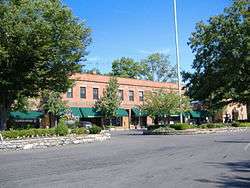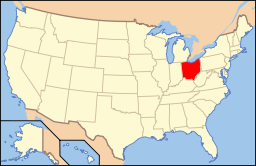Glendale Historic District (Glendale, Ohio)
|
Glendale Historic District | |
 | |
  | |
| Location | SR 747, Glendale, Ohio |
|---|---|
| Area | 392 acres (1.59 km2)[1] |
| Built | 1861 |
| Architect | Multiple |
| Architectural style | Mid 19th Century Revival, Late Victorian and Late 19th and 20th Century Revivals[2] |
| NRHP Reference # | 76001447 |
| Significant dates | |
| Added to NRHP | July 20, 1976[2] |
| Designated NHLD | May 5, 1977[3] |
The Glendale Historic District is a historic district in Glendale, Ohio, listed in the National Register of Historic Places in 1976. It contains 439 contributing buildings.
The Village of Glendale is known for its winding, curvilinear street scapes; its thick tree canopy; its historic homes; & quiet, peaceful living; the citizens of Glendale enjoy a tranquil existence. Glendale is designated a National Historic Landmark, since May 1977, by the U.S. Department of the Interior.
The village maintains its own volunteer fire department, ranked in the top 2% of all Ohio departments. Our police department is recognized for its competency and professionalism, operating out of the oldest, continually operated station in the U.S. We operate our own water and waste water treatment facilities and benefit from the extraordinary efforts of our service department. This small town ambiance and care for maintaining our urban forest: our oasis of calm in an otherwise hectic world, is yet another of the many aspects of Glendale that make it a wonderful place to live. Due to the Village’s location, at the juncture of I-75 & I-275, residents enjoy quick and easy access to all the amenities of Greater Cincinnati. Glendale consists of a land area of 1.7 square miles and a population of 2,155.
Founded in 1855, the Village of Glendale, Ohio is a northern suburb of Cincinnati with a land area of 1.7 square miles and a population of 2,155 people. Glendale is one of only four communities in Hamilton County that does not have an income tax. Known for its quiet, peaceful living, Glendale is a perennial National Arbor Foundation “Tree City” and boasts a much lower than average crime rate, close proximity to a major shopping complex, fast access to the Interstate system, and excellent schools. In 1977 Glendale became the first village in Ohio designated a National Historic Landmark by the U.S. Department of the Interior.
It was declared a National Historic Landmark in 1977.[1][3]

The railroad depot included in the district holds a museum of memorabilia of the village's past, including when John Hunt Morgan went through the village on his great raid.
The district covers 392 acres (1.59 km2) and is an "irregular polygon situated East of State Route 4, north of State Route 126, embracing a portion of the C&O-B&O Railroad right-of-way."[1]
Notes
- 1 2 3 Author unavailable (Date unavailable). "National Register of Historic Places Inventory-Nomination: Glendale Historic District" (pdf). National Park Service. Check date values in:
|date=(help) (incomplete scanned copy) and Accompanying 37 photos, from 1866, 1975, 1976, and undated (32 KB) - 1 2 National Park Service (2007-06-30). "National Register Information System". National Register of Historic Places. National Park Service.
- 1 2 "Glendale Historic District". National Historic Landmark summary listing. National Park Service. Retrieved 2008-04-12.
External links
| Wikimedia Commons has media related to Glendale Historic District. |
Coordinates: 39°16′17″N 84°27′49″W / 39.27139°N 84.46361°W

